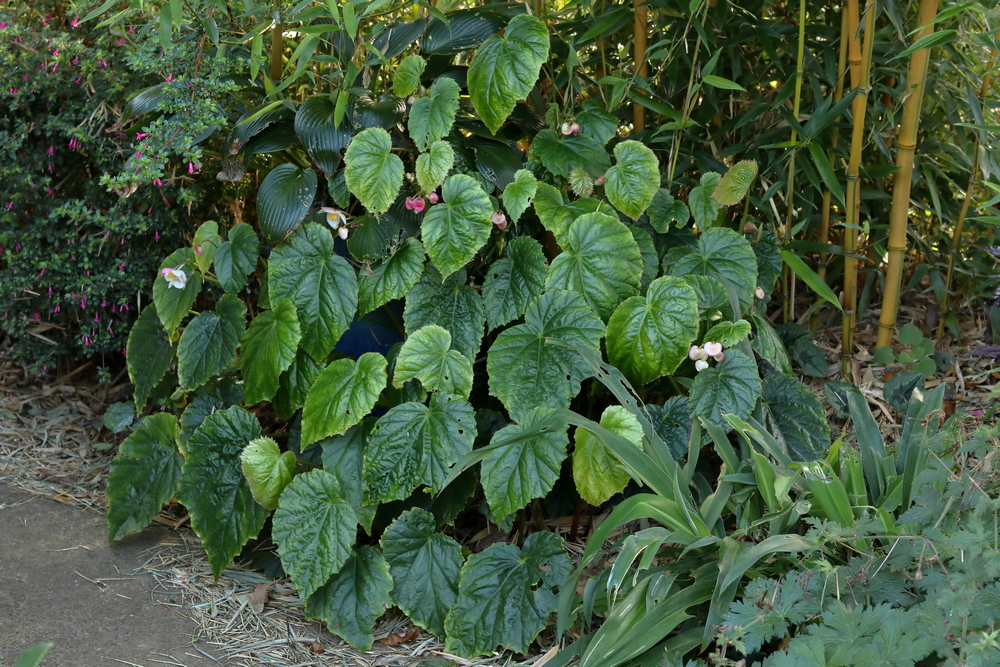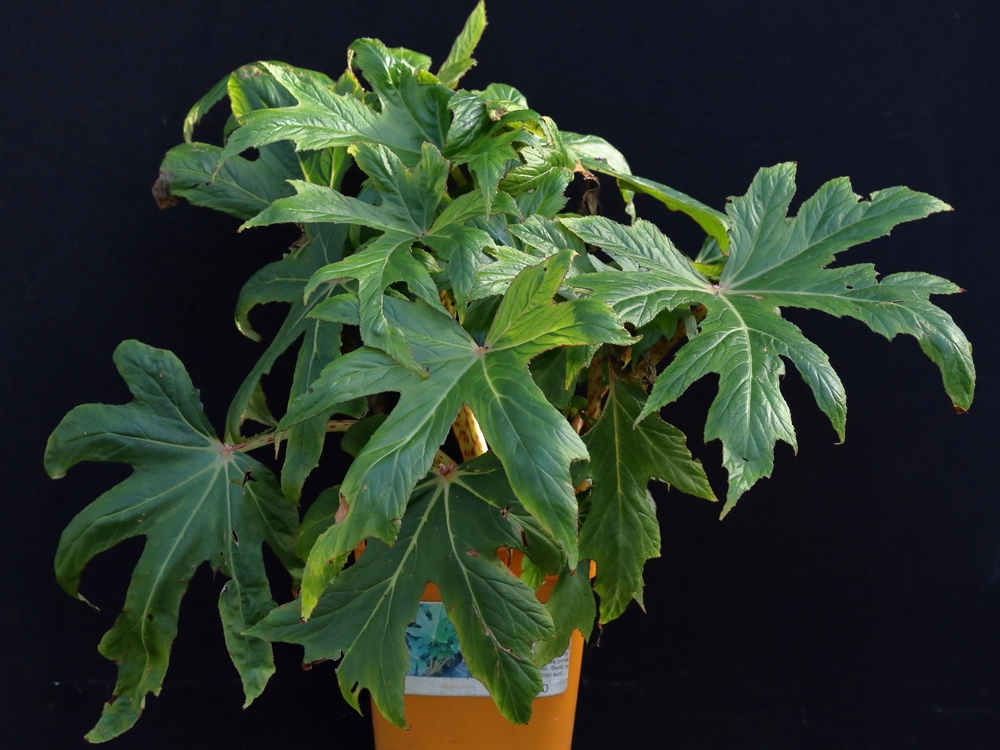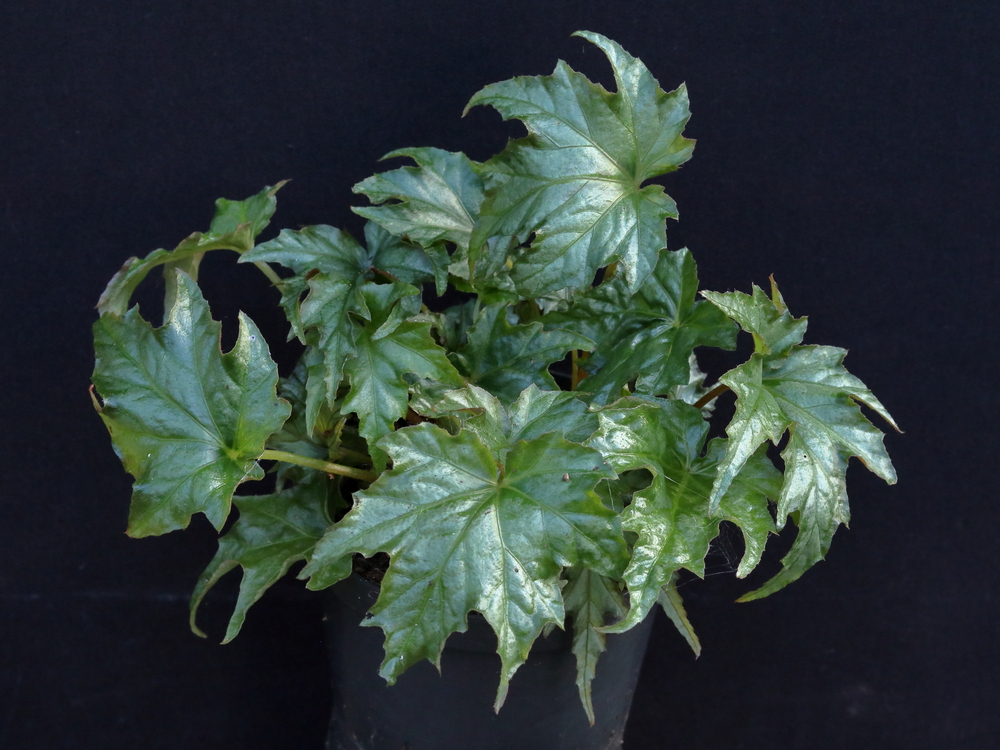Years ago a gardening friend gave me plants of both pink and white forms of Begonia grandis. It would appear that the correct names for them are Begonia grandis subsp. evansiana and Begonia grandis subsp. evansiana var. alba hort. The white form has proved the more robust but both are good performers if grown in moist soil in shade, flowering from late September until November. After this the plants collapse and go completely dormant until late spring/early summer in the following year. As they go down, both produce prodigious quantities of bulbils in their leaf and stem axils and these either drop into the leaf litter around the plants and “germinate” in spring or they can be collected and overwintered in broadly analogous conditions, then brought earlier into growth to be planted out when of a suitable size.
With the good garden performance of these two forms in mind I have been tempted by several other forms of Begonia grandis I have seen on offer, thinking they be as good or better and hopefully distinct in some particular way.
Begonia grandis subsp. holostyla ‘Nanjiang Silver’ was the first form to which I succumbed. I bought this as bulbils from Growild Nursery; they currently list 8 bulbils for £4.25 (sold out) and presumably seed for£3.50. The bulbils I received were tiny but still produced a number of good plants which I kept in small pots through their first year, planting them in the garden in their second year once they’d come back into growth. It hasn’t grown very tall, around 30cm max, with silver markings on the leaves but not very prominent. The flowers are a pretty, very pale pink. It produces very many usually tiny bulbils which detach readily and are hard to spot. In ideal conditions, under a glasshouse bench for example, I could see it quickly becoming a bit of a classy weed. It has not coped well with this summer’s dry weather where I have it planted, which is probably too dry and is sunny for part of the day.
Begonia grandis ‘Heron’s Pirouette’ was the next addition, purchased as two bulbils for £4.50 a year ago, again from Growild Nursery. I now have two good plants in 9cm pots in the greenhouse, around 40cm tall with pink flowers. The plant is all green except for red petioles and red stems just above each node. A great many bulbils are forming and I need to place the plants where I can collect them up as they drop. At Growild’s prices I am looking at £100’s worth at least.
Begonia grandis subsp. sinensis BWJ8011A, and ‘Sapporo’, below, were purchases I made from Farmyard Nurseries in late March 2022. The former was purchased as Begonia grandis ssp sinensis BWJ8011A ‘Red Undies’, but the cultivar name is missing on the label that came with it. BWJ8011A identifies it as a Crûg Farm Nursery plant and on their website Begonia sinensis BWJ8011a and Begonia sinensis ‘Red Undies’ BWJ8011 are the two forms on offer, described as the Chinese counterpart to the Japanese Begonia grandis. The illustrations make it clear that it is ‘Red Undies’ that I have; I suspect 8011a is the selection of 8011 that was given the cultivar name ‘Red Undies’.
It is a distinctive plant, upright to 50cm with relatively small and sharply serrate leaves, red beneath with darker red veins showing through as red on the top surface. The flowers are pink. Bulbils are forming in the stem and leaf axils.
Begonia grandis ‘Sapporo’ quickly outgrew its pot and was planted out in the ground where it continued to make good growth through this year’s hot summer. It is now in flower at around 50cm and is a handsome plant. The leaves are dark green above, dark red beneath. The stems above each node and the petioles are red, the flower stalks vividly so. Bulbils are forming in the stem and leaf axils. It is described as being a particularly hardy form from a cold part of Japan, so should sail through the winter here.
When I received the two Begonias from Farmyard Nurseries on 5th April they were completely dormant. B. grandis ‘Sapporo’ was soon out of the blocks and growing strongly but B. ‘Red Undies’ was still dormant a month later and I could see no sign of it in the pot. I was offered a replacement but I said I’d take a credit against a future order. A week or so later the plant started to grow, around mid May. Outdoors that would not have seemed late but under glass I had expected to see something earlier.
Begonia tengchiana was another plant in the same Farmyard Nurseries order as those above. In an August blog it had started to flower and was doing well. It has continued in the same vein, attractive in a quiet way, with good looking foliage and a steady supply of flowers but only ever a few at a time. Close by it in the garden is Begonia ‘Garden Angel Blush’ which has for months been one of the stand-out plants of the season. Again, it doesn’t have a great flower display but more than makes up for it with its stunning foliage. It is one of a series of three and I have now obtained ‘Garden Angel Silver’ which was on sale at Trevenna Cross Nursery along with ‘Garden Angel Plum’. It was looking a bit past its sell by date but I judged it an improver. ‘Garden Angel Plum’ would have needed a serious discount to temp me and it didn’t have one.
The visit to Trevenna Cross was a “while we are this far down” afterthought to our visiting the plant fair at Tremenheere in September. From Desert to Jungle, who had a stand there, I purchased Begonia koelzii. This is described on its label as being from Manipur in India, with no indication as to its hardiness. On Pan Global Plants’ website it is described as a very recently described new species and the form being offered has a collection number NJM12.077 which leads me to think Nick Macer, of Pan Global, was probably the person who described and introduced it. He says it has withstood -10°C. As well as having a striking palmate leaf, it produces plantlets from where the leaves attach to the petiole, so I have a small plant hopefully growing away in my propagator which will provide insurance when the original is planted out next year.
The plant I bought at Tregrehan under the name Begonia aff. panchtharensis has grown strongly all season and my plans to lift it for the winter have been reduced to lifting part of what is now a meter wide plant. For foliage and vigour it gets top marks, for flower much less. Such as it had were early and largely hidden by the foliage, since mid summer it hasn’t flowered again.
Begonia U614, the Michael Wickenden plant originally and erroneously described as B. sikkimensis, has had its best year yet for me. It has grown well, with large, very deeply divided silvery leaves, and since mid August, a respectable quantity of white flowers. With luck it will set more seed this year, which I will be unable to resist attempting to grow. The small number of seedlings that I have from it from a couple of years back continue to make progress and one is gradually becoming more like its parent, with the leaves gradually becoming more deeply lobed and starting to show some silvering.
My thoughts are turning to how I deal with all the Begonias over the winter and simple lack of undercover space seems likely to dictate that many will stay in the ground. A few I will definitely lift, some I will protect with a leafy mulch and be ready to protect further in very cold spells. In every possible case I will have small plants as backup somewhere under cover but heating this winter will be very frugally applied. Crossing my fingers won’t help but I shall do it anyway.











As with Begonia rex, which was a very popular house plant back in the days, almost all these begonias have attractive foliage, a great benefit as the flowers are not always the most eye-catching.
LikeLike
Sue has often said that I’m a serial obsessive, I’ve certainly got the Begonia bug at the moment. A cold winter would cure me.
LikeLiked by 1 person
Do cross your fingers, because it seems you know a great deal about these plants. You have the knowledge, now you need good luck.
LikeLike
I mainly want for any serious cold weather to not happen when I’m away. If I’m here and things suffer, I’ve only myself to blame.
LikeLiked by 1 person